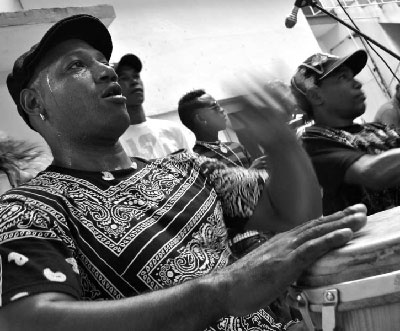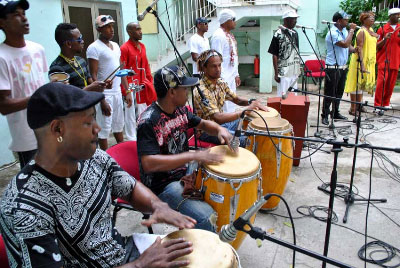The Rumba Is Also Cuba
Dariela Aquique (Photos: Caridad)

HAVANA TIMES – The institutions from this country have taken on the delicate project of preserving the most identifiable features of our cultural arsenal. The most notable example is that of having declared the Rumba part of our national cultural patrimony. And it is precisely to this family of Cuban musical rhythms and dance style that I want to dedicate this article.
The Rumba can be found everywhere: on the corner, on a Sunday afternoon, when a group of friends get together and beat out the rhythm on the chairs, or on the domino table; in a patio of Havana or Matanzas; or in the crowded poor neighborhood housing of Santiago or Guantanamo.
It appears in the repertories of our musicians, fused with other beats. It makes everyone move their legs and hips, from the children to elderly ladies and the dance experts. Or it moves the foreign tourists to invent not-so-well coordinated steps.
After consulting such websites as lajiribilla.cu, cubarte.cult.cu, and guije.com, and as a spectator of so many explosions of rumba, I came to a conclusion: like the Son or the Trova, it’s one of the musical styles that most identify us in the world. The Rumba is Cuba.
Origins
This musical complex has African roots. It originated in Cuba during the Spanish colonial period as a folkloric dance, made up of beats, songs, dances and pantomimes. This also coincided with the period of expansion of the sugar crop.
It’s one of our musical manifestations with the greatest popular and traditional prestige. Its principal protagonists were the freed blacks and their descendents from different African ethnicities such as the Lucumí, Gangá, Arará and perhaps the most important of all, the Gangá-Bantú.
There are historical references to this music from the 18th and 19th centuries, associated with places like workers’ barracks and rural dwellings, as well as in suburban zones like the outbuildings of the sugar refineries or the villages that sprang up around the sugar mills. The men realized aggressive dances known as the “peanut dance”, which could be considered as very primitive rumbas.
They were accompanied by a group of three very primitive lay drums which were beaten with some type of metal instruments, such as the hoes with which they plowed. There were other, very erotic couples’ dances called “macutas”, which may have been the basis for other Rumba styles like the contemporary Guaguancó which has a more urban character.
From that time on, the rumba became synonymous with parties where there was dancing and singing, but where there was also food and alcoholic beverages. Or sometimes Oricha, a deity, was called down, so that it also had a religious connotation.
History and Development
Originally a folkloric Afro-Cuban dance that served as a fertility dance, in the 17th century it formed the basis of a ballroom dance with the Cuban son as a starting point. It was danced in taverns, bars and similar places of the era.
It became more widely popular in the first decades of the 20th century. Our Anglo-Saxon friends typically used the word rumba to denominate nearly all the Cuban dances, without noting the differences.
Actually, “rumba” is a collective term that encompasses a great variety of dance forms. Many of the forms that later developed were limited only to Cuba. The sugar plantations in Havana and Matanzas were the principal centers of evolution of the Rumba.

It arrived in Europe in 1930, commercialized via New York where it had already taken on various elements of Jazz, thanks to our emblematic Chano Pozo. Chano, a dancer and drummer, who in 1946 moved to the United States, became among other things a dancer with Katherine Duna and a percussionist with the Dizzy Gillespie orchestra where he introduced these Cuban rhythms.
Some of the songs that the Gillespie band recorded with Chano Pozo, such as “Cubana Be-Cubana Bop”, or “Manteca”, “Woody’n You”, “AfroCubano Suite” or “Algo Bueno” are potpourris of different rhythms that owe a lot to our rumba.
During the Third Reich the Rumba was prohibited and interest began falling off in other countries. Following the Second World War, however, there was a rebirth of this fascinating dance. From 1956 until 1958 and from 1961 to 1963, two “Rumba Wars” were waged between Great Britain and France to standardize their variations of the Rumba. The fight ended with the decision of the international committees to accept both variants.
Our Rumba
In Cuba, this always has been and always will be something very special. The songs often speak of the daily life of working class people of color. Three principal rumba styles can be distinguished : El Yambú, the Columbia (typical of Matanzas) and the Guaguancó (typical of Havana).
The Yambú: with urban origins, this appears to be one of the oldest styles, since the references to it date from the middle of the 19th century. Its tempo is slow and begins with a choral “lalalaio” called the Diana.
Later the soloist sings some verses, called the Decimar, although often this structure has nothing to do with the Spanish poetical form also called the “decima”.
The chorus responds once more with the distinctive “lalalaiyo” and they continue alternating between the soloist and the chorus until the refrain comes in, where a couple dances. The dance is soft with ceremonious movements representing a woman flirting with the man. It’s worth noting that in the Yambú the spotlight is on the woman, with the male dancer relegated to a secondary role.
The Columbia: is generally a dance of men only, although there are some women who became famous for interpreting this style. This variation undoubtedly had a rural origin. For the great Rumba dancers and musicians, the Columbia style evokes the countryside, especially the area of Matanzas.
The songs may take their inspiration from a large variety of topics, but are expressed in brief unpolished phrases, with an abundance of African expressions, as is natural in the creation of a human art form that arose from the cane plantations or the sugar mill barracks.
Its structure – soloist-chorus – is the same as the other rumba styles, and presents two clearly defined parts. The singing part, the” Llorao”, is characteristic of the Columbia and consists of a series of laments or exclamations of pain that the singer or “Rooster” lets loose with in the middle of his verses. The second part is the dancing part, called the Capetillo.
When the moment of the dance arrives, one of the participants in the party gestures for permission to dance and after clearing a space for him or herself amidst those present and saluting the drummers, the dancer shows off his dancing abilities.
Later another dancer will step in to substitute, attempting to better his/her dance moves. The Game or style of the dancers is “legs and shoulders”, maintaining an erect position, while many times also balancing a glass or drink bottle on their heads.
In some areas of the countryside they are accustomed to dancing with machetes or knives in their hands. The tempo of the Columbia is “rapid but well seated.”
The Guaguancó: is the most elaborate, in terms of both the music and the words. It’s a dance that is typical of the black neighborhoods of Havana. It’s sung entirely in Spanish instead of using African expressions or slang expressions from the poorer barrios.

As far as the words go, the guaguancó bears a close relationship to the “Cuban punto (point)”, the form that the musical improvisations from the Canary Islands and Andalucia took on in Cuba. The tempo of the guaguancó is slightly slower than that of the Columbia but faster than the Yambú. The guaguancó also bears some musical relation with the Flamencan “Cante Jondo”.
The theme is frequently tragic, or at least melancholic. The dance represents a man engaged in an amorous persecution of a woman: he desiring to “Vaccinate her” (an erotic pelvic movement) and she trying humorously to protect herself from the attack. In this deeply voluptuous representation of persecution and flight, the dance partners show off their dancing skills.
What instruments are used in the Rumba?
The musical instruments used to play the rumba are simple: three dueling drums of staves lightly held together, respectively called the “Quinto” (fifth), the “Salidor”(argumentative) y the “Tres Golpes” (three blows). Then there is a pair of metallic marugas (nkembi) that the drummer of the “quinto” uses on his wrists in the Columbia style, and a pair of “nails”, or sticks that the singer strikes together to mark the beat.
Generally in the Yambú and sometimes in the Guaguancó two boxes or wooden containers are used. The smaller one, almost always made out of a small candle box, has a higher sound and serves as the Quinto; the larger, one of those large containers used to bring cod in to market, has a lower sound and serves as a bass drum.
Added to this are beaten spoons, taps on the doors and on anything that lets the rumba players enhance their rhythm.
End of the story
The best known Rumba groups in Cuba are Lolo Yonkori, directed by Alberto Sayas, Celeste Mendoza y su grupo de Guaguancó, Clave y guaguancó directed by Dedo, the Grupo de guaguancó with Carlos Embales as the singer, Los Papines, and Los Muñequitos de Matanzas.
In our country there isn’t a single town that doesn’t have a group or a place to hear Rumba and to mention all of them would create a very long list. But I wouldn’t want to omit group, Yoruba Andabo, that has managed to create true symphonies with their rumba arrangements.
Although Havana and Matanzas are still the great Rumba capitals in Cuba, this style is played and danced all over the country. Among blacks and whites, among smoothies and the sophisticated, by the unschooled and the university professor, by everyone, because the Rumba is also Cuba.

Thank you for sharing this knowledge of the genre my body has never been able to resist. It means a lot to me to learn and understand the roots of my favorite way to celebrate life and my Cuban roots!
La tahona y el tango congo son otras dos modalidades de la rumba, según cuenta Manuel Moreno Fraginals en su libro El Ingenio.
What a beautiful article 🙂